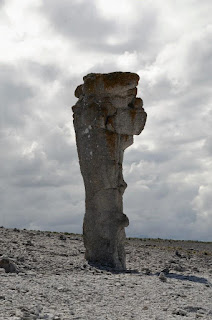Alfred Stieglitz, Portrait of Georgia O'Keeffe, 1918
Source: Wikimedia Commons
We had a good look round this exhibition at Tate Modern yesterday and got the sense of an artist engaged with New Mexico's indigenous inhabitants and culture as well as it's shapes and shadows, hard blue skies and extraordinary colours. Olivia Laing wrote a great piece about O'Keeffe that describes her first experience of the place. 'Back in 1929 she had spent a summer in Taos with the painter Beck Strand. The pair were taken up by a community of powerfully independent women, among them Mabel Dodge Luhan, the formidable heiress and art patron, and the Hon Dorothy Brett, a stone-deaf Englishwoman who carried a knife in her boots.' It sounds fun, although O'Keeffe arrived in Taos too late to encounter D. H. Lawrence. She did paint The Lawrence Tree (1929) though, with a viewpoint right up its trunk and into the night sky. In Tate Magazine artist Lucy Stein writes of this painting that 'the mental image that this summons of two of the titans of nature-worshipping modernism having cosmic and sexy thoughts beneath this ancient pine is as intoxicating as the picture itself.'
I will conclude here with a longer quote from Olivia Laing on the New Mexico period (I would agree with what she says here of the potential strengths and weaknesses of these paintings). O'Keeffe's work is in copyright but you can see the painting referred to on The Guardian site.
“As you come to it over a hill, it looks like a mile of elephants – grey hills all about the same size with almost white sand at their feet,” O’Keeffe wrote of the Black Place, a remote landscape that inspired her more than any other location. The paintings she made there tip geological form over the threshold of abstraction: the serried hills smashed into shards of grey and puce, bifurcated by yolk-coloured cracks or spills of oily black.
'Hills like elephants sounds an echo of Hemingway, and there is something of his habits of compression at work in O’Keeffe, a desire to erase everything extraneous, to convey emotion without confessing it directly. She painted very flat, making surfaces so smooth she once compared the sensation to roller-skating. The risk is blandness, but it can also produce – The Black Place, 1943, say – cleanly assembled structures that quiver with unvoiced feeling.'
.jpg/474px-O'Keeffe-(hands).jpg)






